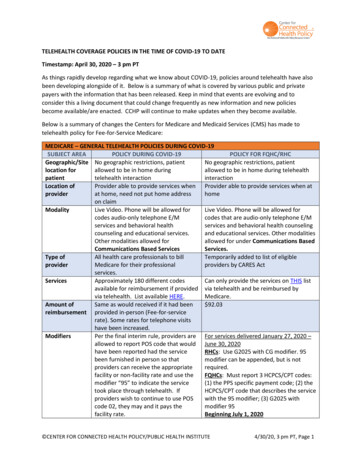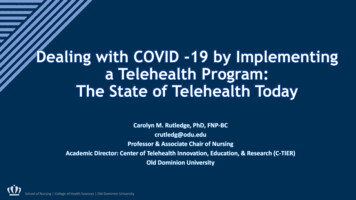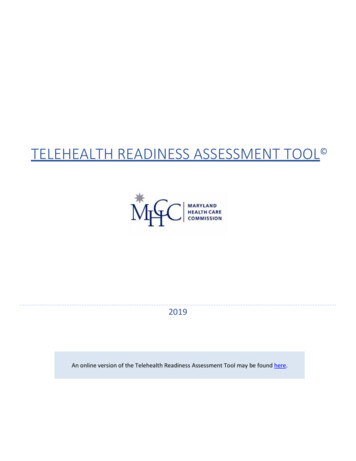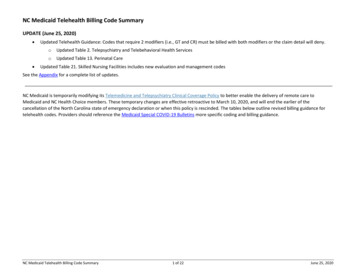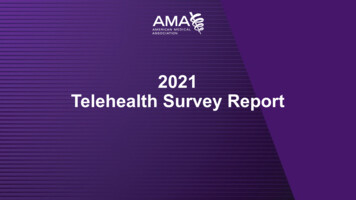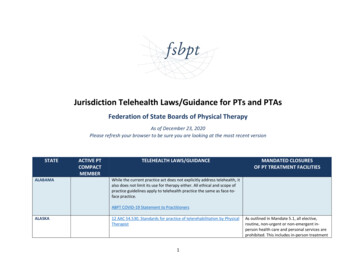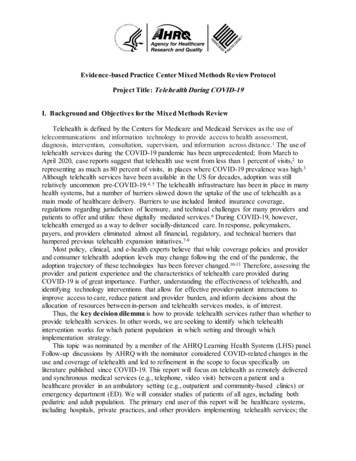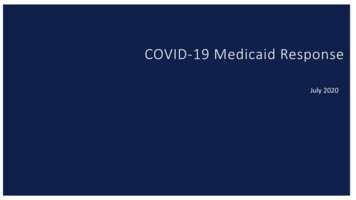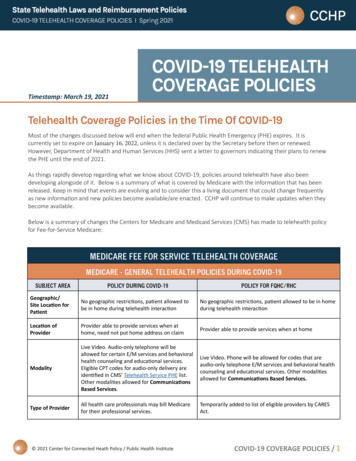
Transcription
State Telehealth Laws and Reimbursement PoliciesCOVID-19 TELEHEALTH COVERAGE POLICIES I Spring 2021Timestamp: March 19, 2021COVID-19 TELEHEALTHCOVERAGE POLICIESTelehealth Coverage Policies in the Time Of COVID-19Most of the changes discussed below will end when the federal Public Health Emergency (PHE) expires. It iscurrently set to expire on January 16, 2022, unless it is declared over by the Secretary before then or renewed.However, Department of Health and Human Services (HHS) sent a letter to governors indicating their plans to renewthe PHE until the end of 2021.As things rapidly develop regarding what we know about COVID-19, policies around telehealth have also beendeveloping alongside of it. Below is a summary of what is covered by Medicare with the information that has beenreleased. Keep in mind that events are evolving and to consider this a living document that could change frequentlyas new information and new policies become available/are enacted. CCHP will continue to make updates when theybecome available.Below is a summary of changes the Centers for Medicare and Medicaid Services (CMS) has made to telehealth policyfor Fee-for-Service Medicare:MEDICARE FEE FOR SERVICE TELEHEALTH COVERAGEMEDICARE - GENERAL TELEHEALTH POLICIES DURING COVID-19SUBJECT AREAPOLICY DURING COVID-19POLICY FOR FQHC/RHCGeographic/Site Location forPatientNo geographic restrictions, patient allowed tobe in home during telehealth interactionNo geographic restrictions, patient allowed to be in homeduring telehealth interactionLocation ofProviderProvider able to provide services when athome, need not put home address on claimProvider able to provide services when at homeModalityLive Video. Audio-only telephone will beallowed for certain E/M services and behavioralhealth counseling and educational services.Eligible CPT codes for audio-only delivery areidentified in CMS’ Telehealth Service PHE list.Other modalities allowed for CommunicationsBased Services.Live Video. Phone will be allowed for codes that areaudio-only telephone E/M services and behavioral healthcounseling and educational services. Other modalitiesallowed for Communications Based Services.Type of ProviderAll health care professionals may bill Medicarefor their professional services.Temporarily added to list of eligible providers by CARESAct. 2021 Center for Connected Heath Policy / Public Health InstituteCOVID-19 COVERAGE POLICIES / 1
State Telehealth Laws and Reimbursement PoliciesCOVID-19 TELEHEALTH COVERAGE POLICIES I Spring 2021MEDICARE FEE FOR SERVICE TELEHEALTH COVERAGEMEDICARE - GENERAL TELEHEALTH POLICIES DURING COVID-19SUBJECT AREAPOLICY DURING COVID-19POLICY FOR FQHC/RHCServicesApproximately 240 different codes available forreimbursement if provided via telehealth. Listavailable HERE. According to CMS finalized2021 physician fee schedule (PFS) some codeswere made permanent, and others will bereimbursable through the end of the year inwhich the PHE ends. See CCHP’s analysis of theCY 2021 PFS HERE.Can only provide the services on THIS list via telehealthand be reimbursed by Medicare.Amount ofReimbursementSame as would receive if it had been providedin-person (Fee-for-service rate). Some rates fortelephone visits have been increased. 92.03ModifiersPer the final interim rule, providers are allowedto report POS code that would have beenreported had the service been furnishedin person so that providers can receive theappropriate facility or non-facility rate and usethe modifier “95” to indicate the service tookplace through telehealth. If providers wish tocontinue to use POS code 02, they may and itpays the facility rate.For services delivered 1/27/20–6/30/20RHCs: Use G2025 with CG modifier. 95 modifier can beappended, but is not required.FQHCs: Must report 3 HCPCS/CPT codes: (1) the PPSspecific payment code; (2) the HCPCS/CPT code thatdescribes the service with the 95 modifier; (3) G2025 withmodifier 95Beginning July 1, 2020: FQHCs/RHCs: Only submitG2025. RHCs should no longer use CG modifier.MEDICARE - OTHER POLICIES RELATED TO TELEHEALTH DURING COVID-19SUBJECT AREAPOLICY DURING COVID-19End State RenalDisease & HomeDialysis PatientsCMS exercising enforcement discretion on requirement that home dialysis patients receiving services viatelehealth must have a monthly face-to-face, non-telehealth encounter in the first initial three monthsof home dialysis and after the first initial three months, at least once every three consecutive months.ESRD clinicians no longer must have one “hands on” visit/month for current required examination ofvascular access site. Clinicians will not have to meet the National Coverage Determination or LocalCoverage Determination of face-to-face visit for evaluations and assessments during this public healthemergency.Nursing HomesCMS waiving requirement that physicians and non-physician practitioners perform in-person visit fornursing home residents and if appropriate, allow them to be done via telehealth.HospiceDuring an emergency period, the Secretary may allow telehealth to meet the requirement that a hospicephysician or nurse practitioner must conduct a face-to-face encounter to determine continued eligibilityfor hospice care. 2021 Center for Connected Heath Policy / Public Health InstituteCOVID-19 COVERAGE POLICIES / 2
State Telehealth Laws and Reimbursement PoliciesCOVID-19 TELEHEALTH COVERAGE POLICIES I Spring 2021MEDICARE - OTHER POLICIES RELATED TO TELEHEALTH DURING COVID-19SUBJECT AREAPOLICY DURING COVID-19Frequency LimitationsThe pre-COVID-19 frequency limitations on subsequent in-patient visit (once every three days),subsequent SNF visit (once every 30 days), and critical care consult (once a day) were removed.SupervisionPhysician supervision may be provided using live video. For other supervision changes, see FAQ BillingGuide.Stark LawsCMS allowing certain waivers: hospitals and other health care providers can pay above or below fairmarket value to rent equipment or receive services from physicians; health care providers can supporteach other financially to ensure continuity of health care operations; and others. See FAQ Billing Guide.Provider Home Address Provider need not put their home address on the claim if they conducted a telehealth visit while aton Claimhome.Out-of-Pocket Costs/Co-PaysStill applies, but the OIG is providing health care providers flexibility to reduce or waive fees. COVID-19testing should be waived.Prior ExistingRelationshipCan be to new and established patients.Hospitals & OriginatingSite FeeHospitals can bill an originating site fee when the patient is at home. See FAQ Billing Guide.Hospital-Only RemoteOutpatient Therapy &Education ServicesHospitals may provide through telecommunication technology behavioral health and education servicesfurnished by hospital-employed counselors or other health professionals who cannot bill Medicaredirectly. Includes partial hospitalization services and can be furnished when the beneficiary is the home.See FAQ Billing Guide.Opioid TreatmentProgramsCounseling and therapy services can be provided by telephone only in cases where the beneficiarydoes not have access to live video. Periodic assessments can be done via live video and telephone ifbeneficiary does not have access to live video.For more resources on Federal telehealth COVID policies, visit the Federal COVID section of CCHP’s online telehealthpolicy finder tool.OTHER MEDICARE & MEDICAID POLICIESMEDICAREEXISTING TELEHEALTH POLICYPRE-COVID-19POLICY CHANGE IN RESPONSE TO COVID-19WHAT CAN BE COVEREDLICENSINGTemporarily waive Medicare and Medicaid requirements to be licensed in the patient state if they are enrolled in Medicare,have valid license in the state which relates to Medicare enrollment, in furnishing services in the state where the emergency isoccurring, and not excluded from practicing in that state or any other state that is part of the emergency. State requirements willstill apply. 2021 Center for Connected Heath Policy / Public Health InstituteCOVID-19 COVERAGE POLICIES / 3
State Telehealth Laws and Reimbursement PoliciesCOVID-19 TELEHEALTH COVERAGE POLICIES I Spring 2021OTHER MEDICARE & MEDICAID POLICIESMEDICAREEXISTING TELEHEALTH POLICYPRE-COVID-19POLICY CHANGE IN RESPONSE TO COVID-19WHAT CAN BE COVEREDMEDICARE ADVANTAGEMedicare Advantage (MA) planshave the flexibility to have moreexpansive telehealth policiesrelated to types of servicescovered, where those servicescan take place (no geographic orsite limitations), modality used.Still limits the types of providersreimbursed.Medicare Advantage Organizations were informed byCMS that if they wish to expand coverage of telehealthservices beyond what has already been approved byCMS, they will exercise its enforcement discretionuntil it is determined that it is no longer necessary inconjunction with the COVID-19 outbreak. (CMS Memo)MA plans have some flexibility toexpand their coverage of telehealthbeyond what they currently do. Whatis covered will depend on what eachplan decides to do. NOTE: MA plansdo NOT have to provide these moreexpansive telehealth services. Theyare only required to provide what iscovered by Fee-for-Service.OTHER TECHNOLOGY-ENABLED SERVICESVirtual Check-In CodesG2010, G2012*Can be done synchronously andasynchronously and telephonecan be usedOther providers such as PTs, OTs and speechlanguage pathologists may bill these codes as wellas G2061-G2063. In the 2021 PFS, this was madepermanent.Can be provided to both new and established patients.They were previously limited to established patients.Virtual check-in codes do not havegeographic or site restrictionsattached so they can be used toengage with patients, but thereimbursement amount for thesecodes is low and are only meant to actas quick check-ins with patients thatdo not last more than a few minutes.Interprofessional Telephone/Internet/EHR Consultations(eConsult) *99446, 99447, 99448, 99449,99451, 99452No Change MadeeConsult allows a provider-to-providerconsultation. Pays both providers, butcheck definition for the time neededfor each code.Remote monitoring services: *Chronic Care ManagementTransitional Care ManagementRemote Physiologic MonitoringPrincipal Care ManagementRemote patient monitoring can be provided to newand established patients. After the PHE, RPM will onlybe available for established patients according to the2021 PFS.These services are not considered“telehealth” services and were neversubject to telehealth limitations. Theydo have other factors that limit howthey can be used so make sure youcheck the definition for the codes.Online Digital Evaluation(E-*Visit) – G2061-2063Online medical Evaluations –99421-99423Can be delivered by clinical social workers, physicaltherapists, occupational therapists and speechlanguage pathologists.These services are not considered“telehealth” services and were neversubject to telehealth limitations.Telephone E/M ServicesAdded by Interim Final Rule. According to 2021 PFS,after the PHE CMS will cease reimbursement for99441-99443 and other audio-only reimbursement,but will instead reimburse for G2252 which includes11-20 min. of medical discussion.98966-98968; 99441-99443. AfterPHE, coverage for these codes willcease, and only coverage for G2252will be available. 2021 Center for Connected Heath Policy / Public Health InstituteCOVID-19 COVERAGE POLICIES / 4
State Telehealth Laws and Reimbursement PoliciesCOVID-19 TELEHEALTH COVERAGE POLICIES I Spring 2021MEDICAIDEXISTING TELEHEALTH POLICYPRE-COVID-19Telehealth reimbursementpolicies vary from state to state.If the State Medicaid programhas managed care, telehealthreimbursement can vary fromplan-to-plan. For Medicaidfee-for-service policies, checkCCHP’s website.POLICY CHANGE IN RESPONSE TO COVID-19A Medicaid FAQ was issued stating that stateMedicaid programs have broad authority to utilizetelehealth within their Medicaid programs includingusing telehealth or telephonic consultations in placeof typical face-to-face requirements when certainconditions are met. States would have to use theAppendix K process for this. See CCHP’s tracking ofstate changes HERE.As noted above, licensure requirements were waivedfor Medicaid, though state requirements would stillapply.WHAT CAN BE COVEREDStill developing. Some states haveencouraged providers and healthplans to utilize telehealth morebroadly to provide services but formany states the policies continue tobe developing as they navigate thissituation.Other Federal ActionsDRUG ENFORCEMENT AGENCY (DEA)The declaration of the national emergency enacted one of the exceptions to the Ryan Haight Act for telehealth(telemedicine as it is referred to in the Act).For as long as the Secretary’s designation of a public health emergency remains in effect, DEA-registered practitionersmay issue prescriptions for controlled substances to patients for whom they have not conducted an in-person medicalevaluation, provided all of the following conditions are met: The prescription is issued for a legitimate medical purpose by a practitioner acting in the usual course of his/herprofessional practice The telemedicine communication is conducted using an audio-visual, real-time, two-way interactive communicationsystem. The practitioner is acting in accordance with applicable Federal and State .htmlHEALTH INSURANCE PORTABILITY and ACCOUNTABILITY ACT (HIPAA)A change was made regarding the Health Insurance Portability and Accountability Act (HIPAA) “Effective immediately,the HHS Office for Civil Rights (OCR) will exercise enforcement discretion and waive penalties for HIPAA violationsagainst health care providers that serve patients in good faith through everyday communications technologies, suchas FaceTime or Skype, during the COVID-19 nationwide public health emergency.“ -topics/emergency-preparedness/index.html 2021 Center for Connected Heath Policy / Public Health InstituteCOVID-19 COVERAGE POLICIES / 5
State Telehealth Laws and Reimbursement PoliciesCOVID-19 TELEHEALTH COVERAGE POLICIES I Spring 2021It should be noted that many states do have laws and regulations regarding health information and what is required toprotect and secure it. This will likely not impact those state laws and regulations. A separate state action will be necessary.OCR Guidance on HIPAA - cement-discretion-telehealth/index.htmlPRIVATE INSURERSPRIVATE INSURERSEXISTING TELEHEALTHPOLICY PRE-COVID-19Coverage varied from payer-topayer, depending on the plan.POLICY CHANGE IN RESPONSE TO COVID-19Several health plans announced that they will maketelehealth more widely available or offering telehealthservices for free for a certain period of time. Some ofthe announcements have come from Aetna, Cigna andBlueShield BlueCross. However, some of these policieshave expired. Check with health plan for their updatedpolicies.WHAT CAN BE COVEREDCommercial payer policies variedduring the pandemic and someexceptions have already expired in2020. Check with your health planfor their updated policies.FQHC’s/RHC’s - HOW CAN I USE TELEHEALTH?The Centers for Medicare and Medicaid Services (CMS) issued FAQs and billing guidance that includes the expandedflexibilities given to Federally Qualified Health Centers (FHQCs) and Rural Health Clinics (RHCs) during the COVID-19Public Health Emergency (PHE) crisis. The CARES Act, HR 748, allowed FQHCs and RHCs to utilize telehealth and act asdistant site providers during a PHE.SEE FACT SHEET CREATED BY CCHP SUMMARIZING THE NEW FQHC/RHC GUIDANCE: Federally Qualified Health Centers& Rural Health Clinics Acting as Distant Site Providers in Medicare 2021 Center for Connected Heath Policy / Public Health InstituteCOVID-19 COVERAGE POLICIES / 6
State Telehealth La ad Reireet Policie COVID-19 TELEHEALTH COVERAGE POLICIES I Sring 1 . Nursing Homes CMS waiving requirement that physicians and non-physician practitioners perform in-person visit for . Stark Laws CMS allowing certain waivers: hospitals and other health care providers can pay above or below fair .
